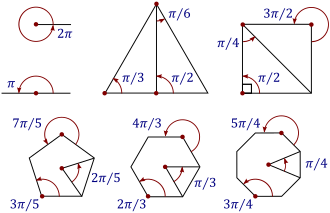Radian
Radian is a unit of measure used in the field of geometry to quantify angles. It is the standard unit of angular measure in the International System of Units (SI), and it is used widely in many areas of mathematics, physics, and engineering. The radian is defined as the angle created at the center of a circle by an arc whose length is equal to the radius of the circle. This definition implies that a full circle encompasses \(2\pi\) radians, which corresponds to 360 degrees, making one radian equal to approximately 57.2958 degrees.
Definition
The radian is defined based on the radius of a circle. Specifically, if the length of an arc of a circle is equal to the radius of that circle, then the angle subtended by that arc at the center of the circle is one radian. Mathematically, this can be expressed as \(1 \, \text{radian} = \frac{\text{arc length}}{\text{radius}}\). This relationship highlights the radian's nature as a ratio and thus a dimensionless unit, which sets it apart from degrees, a unit also used to measure angles but defined arbitrarily as 1/360 of a circle.
Conversion between radians and degrees
To convert between radians and degrees, one can use the fact that \(360^\circ\) is equivalent to \(2\pi\) radians. Therefore, to convert degrees to radians, one multiplies the number of degrees by \(\frac{\pi}{180}\), and to convert radians to degrees, one multiplies the number of radians by \(\frac{180}{\pi}\).
Usage
Radians are widely used in various branches of mathematics, including trigonometry, calculus, and linear algebra, due to their natural properties that simplify many types of calculations. For example, the derivatives of trigonometric functions are simpler when the functions' arguments are given in radians. In physics, radians are used to describe angular velocities and accelerations, among other quantities. Engineers also use radians in the design and analysis of mechanisms and systems that involve rotation or oscillation.
Advantages
One of the main advantages of using radians is that they allow for more straightforward and intuitive equations and formulas. For instance, in calculus, the derivative of the sine function is cos(x) only when x is measured in radians. This simplicity extends to the Taylor series expansions of trigonometric functions and the solutions to many differential equations.
See also
Transform your life with W8MD's budget GLP-1 injections from $125.
W8MD offers a medical weight loss program to lose weight in Philadelphia. Our physician-supervised medical weight loss provides:
- Most insurances accepted or discounted self-pay rates. We will obtain insurance prior authorizations if needed.
- Generic GLP1 weight loss injections from $125 for the starting dose.
- Also offer prescription weight loss medications including Phentermine, Qsymia, Diethylpropion, Contrave etc.
NYC weight loss doctor appointments
Start your NYC weight loss journey today at our NYC medical weight loss and Philadelphia medical weight loss clinics.
- Call 718-946-5500 to lose weight in NYC or for medical weight loss in Philadelphia 215-676-2334.
- Tags:NYC medical weight loss, Philadelphia lose weight Zepbound NYC, Budget GLP1 weight loss injections, Wegovy Philadelphia, Wegovy NYC, Philadelphia medical weight loss, Brookly weight loss and Wegovy NYC
|
WikiMD's Wellness Encyclopedia |
| Let Food Be Thy Medicine Medicine Thy Food - Hippocrates |
Medical Disclaimer: WikiMD is not a substitute for professional medical advice. The information on WikiMD is provided as an information resource only, may be incorrect, outdated or misleading, and is not to be used or relied on for any diagnostic or treatment purposes. Please consult your health care provider before making any healthcare decisions or for guidance about a specific medical condition. WikiMD expressly disclaims responsibility, and shall have no liability, for any damages, loss, injury, or liability whatsoever suffered as a result of your reliance on the information contained in this site. By visiting this site you agree to the foregoing terms and conditions, which may from time to time be changed or supplemented by WikiMD. If you do not agree to the foregoing terms and conditions, you should not enter or use this site. See full disclaimer.
Credits:Most images are courtesy of Wikimedia commons, and templates, categories Wikipedia, licensed under CC BY SA or similar.
Contributors: Prab R. Tumpati, MD

